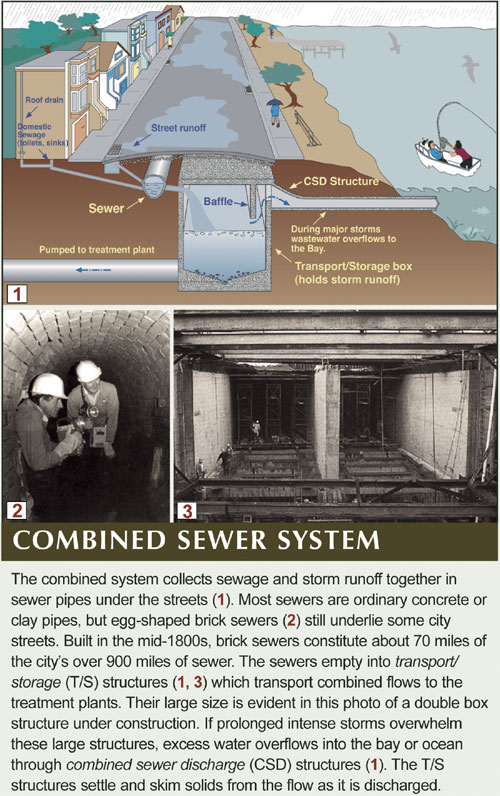Guide to San Francisco Bay Area Creeks
San Francisco Combined Sewers
San Francisco is unique in California as the only city served predominantly by a combined sewer system. San Francisco collects both sewage and stormwater in the same network of pipes, then treats and discharges the combined flows to San Francisco Bay or the Pacific Ocean. Except for portions of Old Sacramento, all other cities in California have separate sewer systems, which means there are two sets of pipes in the ground. One set of pipes takes sanitary waste to the treatment plant while a second set carries stormwater runoff from street drains directly into creeks, lakes, or the ocean.

Stormwater can become polluted with litter, automotive fluids, metals, garden chemicals, and other wastes that wash into storm drains from streets. Untreated, urban stormwater can harm fish and wildlife, and is a leading cause of water pollution in the United States. San Francisco's combined system cleans both stormwater and sewage before release into the environment.
On a typical dry weather day, the system collects and treats more than 80 million gallons of wastewater, primarily municipal sewage. This is enough water to fill 120 Olympic-size swimming pools. During rainy weather, by contrast, the system can collect and treat more than 500 million gallons per day of sewage plus stormwater.
San Francisco�s combined system holds these large volumes of water in underground storage vaults called transport/storage (T/S) structures, which encircle the city. San Francisco built the T/S structures in the 1980s and 1990s to prevent pollution of the bay and ocean during large storms. All combined flows pass into and through these structures on their way to the treatment plants. This upgrade greatly reduced the number of sewage overflows. The current system is designed such that overflows to the bay or ocean now occur on average one to ten times per year, depending on the rainfall and the watershed.
WHY A COMBINED SYSTEM?
Many United States cities built prior to 1900 had combined sewer systems. At that time, sewage treatment was not available and sewers simply directed sewage into local water bodies. When sewage treatment became necessary to protect public health, newer cities built separate systems to save on the costs of treating stormwater. Some of the older cities opted to separate their combined systems. San Francisco, already a dense urban environment, decided that separation was too costly and disruptive to the residents. Separating the sewers would have required ripping open nearly every street for stormwater pipe installations. Today, the treatment of stormwater in San Francisco�s combined sewer system helps protect the environment. Many cities that have separate systems are now initiating treatment of urban runoff.
THE PROBLEM WITH PAVEMENT
Before San Francisco was built, sand dunes, grassy hills, and wetlands absorbed rainwater, replenishing groundwater and streams. Today, hard surfaces such as rooftops, streets, and parking lots prevent rainfall runoff from slowing down and percolating into the ground. Now during rainstorms large volumes of water rush over these impervious surfaces, picking up pollutants and washing them into the combined sewer system. There are only a few small areas of the city where runoff flows into creeks and lakes, or directly into the bay or ocean.
NATURAL DRAINAGE SOLUTIONS
Like many cities around the world, San Francisco is beginning to use green stormwater management methods, which can help reduce the effects of urbanization on stormwater. These methods mimic natural watershed processes primarily by redirecting runoff to vegetated areas, such as landscaped planters, swales, and gardens. These vegetated areas reduce, filter, and slow stormwater runoff, lessening the burden on the combined sewer system.
ONLY RAIN DOWN THE DRAIN
Wastewater treatment plants are designed to clean wastewater containing human waste, oil, and grease. However, they are not able to remove completely other pollutants and these may remain in the water after treatment. We all can help prevent pollution of the bay or ocean by not pouring automotive fluids, yard and garden chemicals, or waste medicines down the sink or toilet, on the ground, or into local storm drains. Bring untreatable wastes to the San Francisco Household Hazardous Waste Facility for recycling or disposal. Call (415) 330-1405 or visit: http://pollutionprevention.sfwater.org.
|
